Decrease of Nozzle Clogging through Fluid Flow Control
Abstract
1. Introduction
2. Materials and Methods
2.1. Main Assumptions and Considerations
- In the present research, the studied clogging mechanism is the inclusion deposition into the inner SEN wall. Other clogging sources as chemical reactions between steel and the nozzle, interaction between steel and slag/refractory interfaces, reoxidation, refractory erosion, growth of the clog, and solidification of the fluid on the wall are not considered in this work.
- The simulation considers unsteady state and isothermal conditions, with the gravity force acting over the negative y coordinate.
- The molten steel was assumed to be an incompressible Newtonian fluid with density ρ = 7100 kg/m3 and viscosity μ = 0.0064 Pa·s.
- The model uses non-slip conditions as boundary conditions at all solid surfaces.
- There is not any external force affecting the fluid dynamic on the system.
- The outer flow field relates to the field inside the boundary layer using the log law.
- Dynamics of inclusions use the flow field data under steady-state conditions in the discrete phase model. The spherical solid inclusions, with alumina properties (ρ = 3960 kg/m3), assuming no interaction among them, were fed at the entry nozzle top center. The studied inclusion sizes were 1, 3, 5,10, 20, 40, 60, 80, and 100 μm. For these particle sizes, the corresponding response times are exceedingly small; in other words, this is a one way coupled flow governed by the liquid phase.
- As a starting point, at the nozzle wall, the typical or general boundary condition of the “trap,” implemented in the ANSYS-FLUENT® (version 16.2.0, ANSYS Inc., Pennsylvania, PA, USA) package, was applied. In this case, “if the inclusion touches the wall, it is considered as attached”.
- The estimation thickness of the boundary layer permits the adoption of a more realistic boundary condition in the wall. In this boundary condition, the inclusion is deposited on the wall, if its radius is smaller than the thickness of the sublaminar boundary layer. Essentially, this boundary condition assumes alternating shear rates with high-speed and low-speed regions near the boundary layer. Therefore, with these conditions, the dynamics of small and large inclusions diverge considerably [26,27,28,29].
2.2. Fundamental Equations and Models
2.3. The Standard k-ε Turbulence Model Subsection
2.4. The Lagrangian Discrete Phase Model
2.5. Numerical Procedure
2.6. The Sub-Laminar Boundary Layer Thickness
Theoretical Thickness of the Sub-Laminar Boundary Layer
3. Results
3.1. Touching Inclusions Percentages
3.2. Analysis of the Nozzle Geometry Effects on the Fluid Dynamics and the Inclusions Distribution
3.3. The Condition for Particle Deposition
- If the inclusion adheres to the wall;
- If the inclusion reflects from the wall.
- For inclusions smaller than 20 μm (10 μm radius indicated by the vertical lines drawn in Figure 9) the probability of being trapped in any zone of the nozzle is high, since its radius is smaller than the thickness of the sub-laminar boundary layer in almost any part of the nozzle. Therefore, these small inclusions will be deposited at the first contact with the wall, making no difference with the above boundary condition.
- For inclusions larger than 40 μm, the deposition must be considerably lower or null because the radius of the inclusions is larger than the thickness of the layer. However, in zone 1 (delimited with chambers or deflectors) the thickness of the boundary layer increases, making it possible for inclusions in this range for deposition, although with minimum percentages. The thickness of the boundary layer is larger on the right side of nozzle A. In this same sense, in the zone ➁ (port zone) again the thickness of the boundary layer is similarly increased in both sides of the nozzle, facilitating the deposition of larger inclusions with percentages even larger than in zone ➀.
4. Validation
4.1. Model Validation
4.2. Validation of the Boundary Condition
5. Conclusions
- The usual criterion of “trap” predicts that more than 50% of the inclusions, reaching the nozzle wall, deposit themselves following a non-uniform manner, regardless of the inclusion size or the nozzle design.
- The thickness of the sublaminar boundary layer is not uniform inside the nozzles and shows a strong dependence on the nozzle geometry and internal design. The layer is thinnest at the side of the slide gate’s opening and thickest near the deflectors and chambers zone, ports, and bottom of the nozzle.
- For inclusions sizes larger than 20 μm, there are low deposition percentages of inclusions. However, for inclusions under 20 μm, the use of the new criterion showed no significant changes despite the presence of the chambers and the deflectors.
- Chambers or deflectors significantly reduce the nozzle clogging by promoting a global decrement of the inclusion deposition at the inner SEN walls. These devices effectively control the fluid flow, counteracting the effects promoted by the slide gate opening, favoring the uniformity of the flow velocity and the turbulent kinetic energy, and also promoting a more stable flow to the discharging ports of nozzles.
- From a fluid-dynamic point of view, nozzle B reduces more the dynamic effects produced by the slide gate.
Author Contributions
Funding
Acknowledgments
Conflicts of Interest
References
- Long, M.; Zuo, X.; Zhang, L.; Chen, D. Kinetic Modeling on Nozzle Clogging During Steel Billet Continuous Casting. ISIJ Int. 2010, 50, 712–720. [Google Scholar] [CrossRef]
- Ni, P.; Jonsson, L.T.I.; Ersson, M.; Jönson, P.G. The Use of an Enhanced Eulerian Deposition Model to Investigate Nozzle Clogging During Continuous Casting of Steel. Metall. Mater. Trans. 2014, 45, 2414–2424. [Google Scholar] [CrossRef]
- Gutiérrez, E.; Garcia-Hernández, S.; de Jesús Barreto, J. Mathematical Modeling of Inclusions Deposition at the Upper Tundish Nozzle and the Submerged Entry Nozzle. Steel Res. Int. 2016, 87, 1406–1416. [Google Scholar] [CrossRef]
- Gutiérrez, E.; Garcia-Hernández, S.; de Jesús Barreto, J. Mathematical Analysis of the Dynamic Effects on the Deposition of Alumina Inclusions inside the Upper Tundish Nozzle. ISIJ Int. 2016, 56, 1394–1403. [Google Scholar] [CrossRef]
- Barati, H.; Wu, M.; Holzmann, T.; Kharicha, A.; Ludwig, A. Simulation of non-metallic inclusion deposition and clogging of nozzle. Miner. Met. Mater. Ser. 2018, 149–158. [Google Scholar] [CrossRef]
- Snow, R.B.; Shea, J.A. Mechanism of Erosion of Nozzles in Open-Hearth Ladles. J. Am. Ceram Soc. 1949, 32, 187–194. [Google Scholar] [CrossRef]
- Braun, T.B.; Elliott, J.F.; Flemings, M.C. The clustering of alumina inclusions. Metall. Mater. Trans. 1979, 10, 171–184. [Google Scholar] [CrossRef]
- Miki, Y.; Kitaoka, H.; Sakuraya, T.; Fujii, T. Mechanism for Separating Inclusions from Molten Steel Stirred with a Rotating Electro-magnetic Field. ISIJ Int. 1992, 32, 142–149. [Google Scholar] [CrossRef]
- Zhang, L.; Thomas, B.G. State of the art in the control of inclusions during steel ingot casting. Metall. Mater. Trans. B 2006, 37, 733–761. [Google Scholar] [CrossRef]
- Sasai, K.; Mizukami, Y. Mechanism of Alumina Adhesion to Continuous Caster Nozzle with Reoxidation of Molten Steel. ISIJ Int. 2001, 41, 1331–1339. [Google Scholar] [CrossRef]
- Tehovnik, F.; Burja, J.; Arh, B.; Knap, M. Submerged entry nozzle clogging during continuous casting of Al-killed steel. Metalurgija 2015, 54, 371–374. Available online: https://hrcak.srce.hr/128965 (accessed on 10 September 2020).
- Fukuda, Y.; Ueshima, Y.; Mizoguchi, S. Mechanism of Alumina Deposition on Alumina Graphite Immersion Nozzle in Continuous Caster. ISIJ Int. 1992, 32, 164–168. [Google Scholar] [CrossRef]
- Sasai, K.; Mizukami, Y.; Yamamura, H. Reaction Mechanism between Alumina Graphite Immersion Nozzle and Low Carbon Steel. J. Iron Steel Inst. Jpn. 1993, 79, 1067–1074. [Google Scholar] [CrossRef]
- Sasai, K.; Mizukami, Y. Reaction Mechanism between Alumina Graphite Immersion Nozzle and Low Carbon Steel. ISIJ Int. 1994, 34, 802–809. [Google Scholar] [CrossRef]
- Singh, S.N. Mechanism of alumina buildup in tundish nozzles during continuous casting of aluminum-killed steels. Metall. Mater. Trans. 1974, 5, 2165–2178. [Google Scholar] [CrossRef]
- Kojola, N.; Ekerot, S.; Andersson, M.; Jönsson, P.G. Pilot plant study of nozzle clogging mechanisms during casting of REM treated stainless steels. Ironmak. Steelmak. 2011, 38, 1–11. [Google Scholar] [CrossRef]
- Yokota, S.; Souma, S.T.; Guchi, M.; Asak, Y.; Hara, S. Prevention of Air Suction from the Contact-part between Sliding Gate and Immersion Nozzle. ISIJ Int. 1998, 38, 1346–1352. [Google Scholar] [CrossRef]
- Rackers, K.; Thomas, B.G. Clogging in Continuous Casting Nozzles. 78th Steelmaking Conf. Iron Steel Soc. 1995, 78, 723–734. Available online: http://ccc.illinois.edu/PDF%20Files/Publications/95_ISS%5B1%5D.Conf.paper_post.pdf (accessed on 18 September 2020).
- Savolainen, J.; Rousu, A.; Fabritius, T.; Mattila, O.; Sulasalmi, P. Modelling of Pressure Distribution inside the SEN in a Stopper-rod controlled Syste. Steel Res. Int. 2010, 81, 980–986. [Google Scholar] [CrossRef]
- Vermeulen, Y.; Coletti, B.; Blanpain, B.; Wollants, P.; Vleugels, J. Material Evaluation to Prevent Nozzle Clogging during Continuous Casting of Al Killed Steels. ISIJ Int. 2002, 42, 1234–1240. [Google Scholar] [CrossRef]
- Lee, J.H.; Kang, Y.B. Growth of Initial Clog Deposits during Continuous Casting of Ti-ULC Steel Formation and Reduction of the Initial Deposits at Nozzle/Steel Interface. ISIJ Int. 2020, 426–435. [Google Scholar] [CrossRef]
- Lee, J.H.; Kang, M.H.; Kim, S.K.; Kang, Y.B. Oxidation of Ti Added ULC Steel by CO Gas Simulating Interfacial Reaction between the Steel and SEN during Continuous Casting. ISIJ Int. 2018, 1257–1266. [Google Scholar] [CrossRef]
- Lee, J.H.; Kang, M.H.; Kim, S.K.; Kim, J.; Kim, M.S.; Kang, Y.B. Influence of Al/Ti Ratio in Ti-ULC Steel and Refractory Components of Submerged Entry Nozzle on Formation of Clogging Deposits. ISIJ Int. 2019, 749–758. [Google Scholar] [CrossRef]
- Barati, H.; Wu, M.; Kharicha, A.; Ludwig, A. A transient model for nozzle clogging. Powder Techn. 2018, 181–198. [Google Scholar] [CrossRef]
- Barati, H.; Wu, M.; Kharicha, A.; Ludwig, A. Calculation Accuracy and Efficiency of a Transient Model for Submerged Entry Nozzle Clogging. Metall. Mater. Trans. B 2019, 1428–1443. [Google Scholar] [CrossRef]
- Rashidi, M.; Hetsroni, G.; Banerjee, S. Particle-turbulence interaction in a boundary layer. Int. J. Multiph. Flow 1990, 16, 935–949. [Google Scholar] [CrossRef]
- Kaftori, D.; Hetsroni, G.; Banerjee, S. Particle behavior in the turbulent boundary layer. I. Motion, deposition, and entrainment. Phys. Fluids 1995, 7, 1095–1106. [Google Scholar] [CrossRef]
- Hishida, K.; Ando, A.; Maeda, M. Experiments on particle dispersion in a turbulent mixing layer. Int. J. Multiph. Flow 1992, 18, 181–194. [Google Scholar] [CrossRef]
- Kaftori, D.; Hetsroni, G.; Banerjee, S. The effect of particles on wall turbulence. Int. J. Multiph. Flow 1998, 24, 359–386. [Google Scholar] [CrossRef]
- Smirnov, A.N.; Efimova, V.G.; Verzilov, A.P.; Maksaev, E.N. Clogging of submersible nozzles in continuous slab-casting machines. Steel Transl. 2014, 44, 833–837. [Google Scholar] [CrossRef]
- Wu, S.; Zhang, J.; Li, Z. Mathematic Model of SEN Clogging During Continuous Casting of Steel. J. Iron Steel Res. Int. 2010, 17, 6–9. [Google Scholar] [CrossRef]
- Zhang, L.; Thomas, B.G. State of the Art in Evaluation and Control of Steel Cleanliness. ISIJ Int. 2003, 43, 271–291. [Google Scholar] [CrossRef]
- Yuan, Q.; Thomas, B.G.; Vanka, S.P. Study of transient flow and particle transport in continuous steel caster molds: Part I. Fluid flow. Metall. Mater. Trans. 2004, 35B, 685–702. [Google Scholar] [CrossRef]
- Bolender, T.; Jacobi, H.; Weinberg, M.; Wünnenberg, K. Mixing and Oxide Cleanness in Sequence Casting of Heats of Differing Compositions. Steel Res. Int. 2007, 78, 31–38. [Google Scholar] [CrossRef]
- Deng, Z.; Zhu, M.; Zhong, B.; Sichen, D. Attachment of Liquid Calcium Aluminate Inclusions on Inner Wall of Submerged Entry Nozzle during Continuous Casting of Calcium-Treated Steel. ISIJ Int. 2014, 54, 2813–2820. [Google Scholar] [CrossRef]
- Bai, H.; Thomas, B.G. Effects of Clogging, Argon Injection, and Continuous Casting Conditions on Flow and Air Aspiration in Submerged Entry Nozzles. Metall. Mater. Trans. B 2001, 32, 707–722. [Google Scholar] [CrossRef]
- Hyunjin, Y.; Vanka, S.P.; Thomas, B.G. Modeling Argon Gas Behavior in Continuous Casting of Steel. CFD Modeling and Simulation in Materials Processing 2018, 1st ed.; Nastac, L., Pericleous, K., Sabau, A., Zhang, L., Thomas, B., Eds.; Springer: Cham, Switzerland, 2018; Volume 1, pp. 2148–2156. [Google Scholar]
- Klaus, T.; Shevchenko, N.; Röder, M.; Anderhuber, M.; Gardin, P.; Eckert, S.; Gerbeth, G. Visualization of liquid metal two-phase flows in a physical model of the continuous casting process of steel. Metall. Mater. Trans. B 2015, 46, 700–710. [Google Scholar] [CrossRef]
- Javurek, M.; Thumfard, M.; Wincor, R. Investigations on Flow Pattern and Pressure inside SEN below Stopper Rod. Steel Research Int. 2010, 81, 668–674. [Google Scholar] [CrossRef]
- Liu, R.; Thomas, B.G. Model of Gas Flow Through Porous Refractory Applied to an Upper Tundish Nozzle. Metall. Mater. Trans. B 2014, 46, 388–405. [Google Scholar] [CrossRef]
- Calderon-Ramos, I.; Morales, R.D. Influence of Turbulent Flows in the Nozzle on Melt Flow within a Slab Mold and Stability of the Metal–Flux Interface. Metall. Mater. Trans. 2016, 47, 1866–1881. [Google Scholar] [CrossRef]
- Calderon-Ramos, I.; Morales, R.D.; Garcia-Hernandez, S.; Ceballos-Huerta, A. Effects of immersion depth on flow turbulence of liquid steel in a slab mold using a nozzle with upward angle rectangular ports. ISIJ Int. 2014, 54, 1797–1806. [Google Scholar] [CrossRef]
- Arcos-Gutierrez, H.; Barrera-Cardiel, G.; de Jesús Barreto, J.; Garcia-Hernandez, S. Numerical Study of Internal SEN Design Effects on Jet Oscillations in a Funnel Thin Slab Caster. ISIJ Int. 2014, 54, 1304–1313. [Google Scholar] [CrossRef]
- Mizobe, A.; Ueki, M. Design of nozzle for steel continuous casting system based on flow analysis II -Submerged entry nozzle (SEN). J. Adv. Mech. Des. Syst. Manuf. 2018, 12, 1–12. [Google Scholar] [CrossRef]
- González-Solórzano, M.G.; Morales, R.D.; Gutiérrez, E.; Guarneros, J.; Chattopadhyay, K. Analysis of Fluid Flow of Liquid Steel through Clogged Nozzles: Thermodynamic Analysis and Flow Simulations. Steel Res. Int. 2020, 1–14. [Google Scholar] [CrossRef]
- Launder, B.E.; Spalding, D.B. The numerical computation of turbulent flows. Comp. Meth Appl. Mech. Eng. 1974, 3, 269–289. [Google Scholar] [CrossRef]
- Fluent Inc. Fluent Guides; Fluent Inc.: Lebanon, NH, USA, 2007. [Google Scholar]
- Sun, C.; Guo, Y.; Li, Q.; Shen, Z.; Zheng, T.; Wang, H.; Ren, W.; Lei, Z.; Zhong, Y. Numerical Simulation on Saffman Force Controlled Inclusions Removal during the ESR Process. Metals 2020, 10, 647. [Google Scholar] [CrossRef]
- Holland, F.A.; Bragg, R. Fluid Flow for Chemical Engineers, 2nd ed.; Butterworth-Heinemann: Oxford, UK, 1973; pp. 89–93. [Google Scholar] [CrossRef]
- Ni, P.; Jonsson, L.; Ersson, M.; Jönsson, P. Turbulent Flow Phenomena and Ce2O3 Behavior during a Steel Teeming Process. ISIJ Int. 2013, 53, 792–801. [Google Scholar] [CrossRef][Green Version]
- Zhang, L.; Wang, Y.; Zuo, X. Flow Transport and Inclusion Motion in Steel Continuous-Casting Mold under Submerged Entry Nozzle Clogging Condition. Metall. Mater. Trans. 2008, 39, 534–550. [Google Scholar] [CrossRef]
- Yokoya, S.; Takagi, S.; Ootani, S.; Iguchi, M.; Marukawa, K.; Hara, S. Swirling Flow Effect in Submerged Entry Nozzle on Bulk Flow in High Throughput Slab Continuous Casting Mold. ISIJ Int. 2001, 41, 1208–1214. [Google Scholar] [CrossRef]
- Yokoya, S.; Westoff, R.; Asako, Y.; Hara, S.; Szekely, J. Numerical Study of Immersion Nozzle Outlet Flow Pattern with Swirling Flow in Continuous Casting. ISIJ Int. 1994, 34, 889–895. [Google Scholar] [CrossRef]
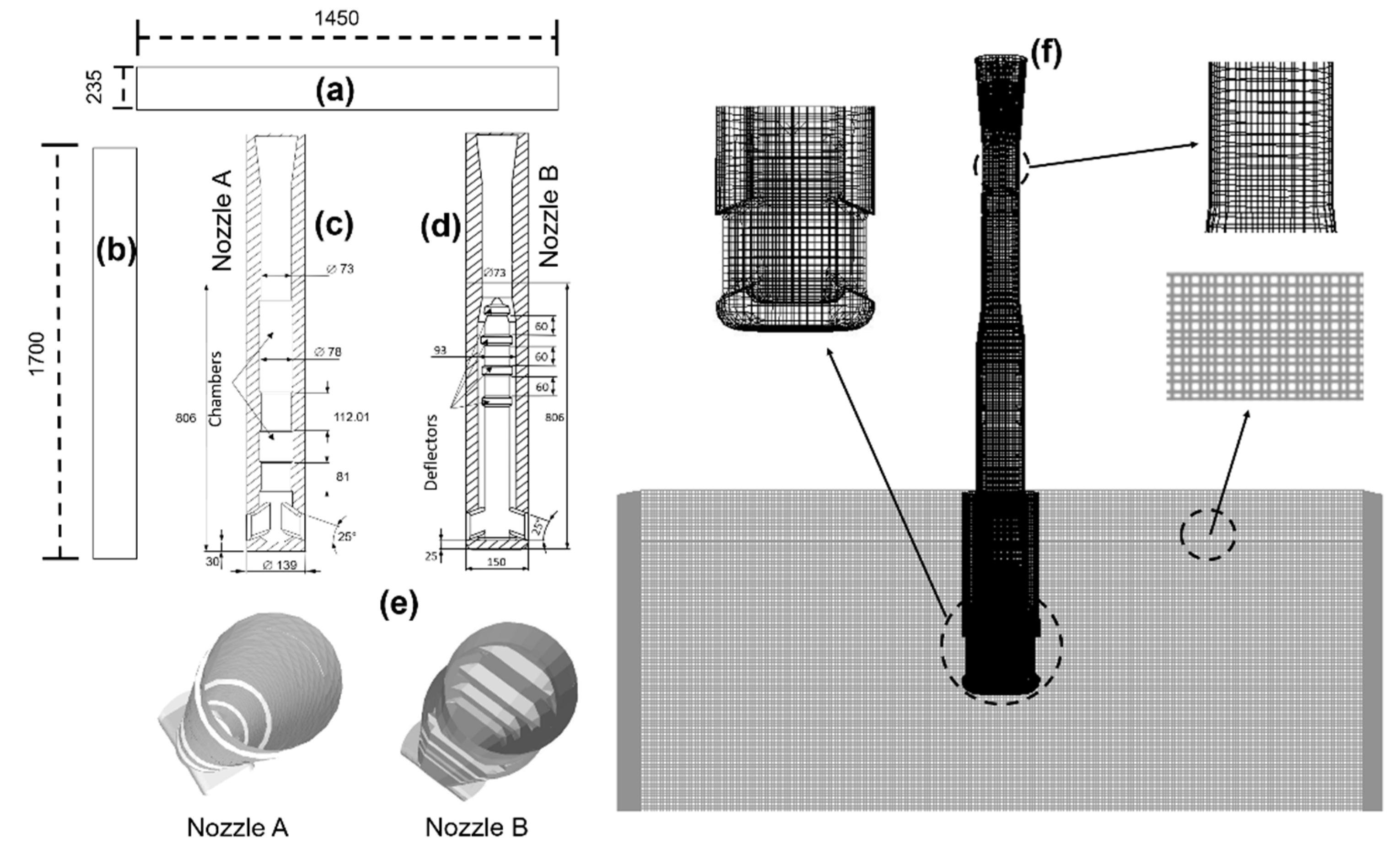
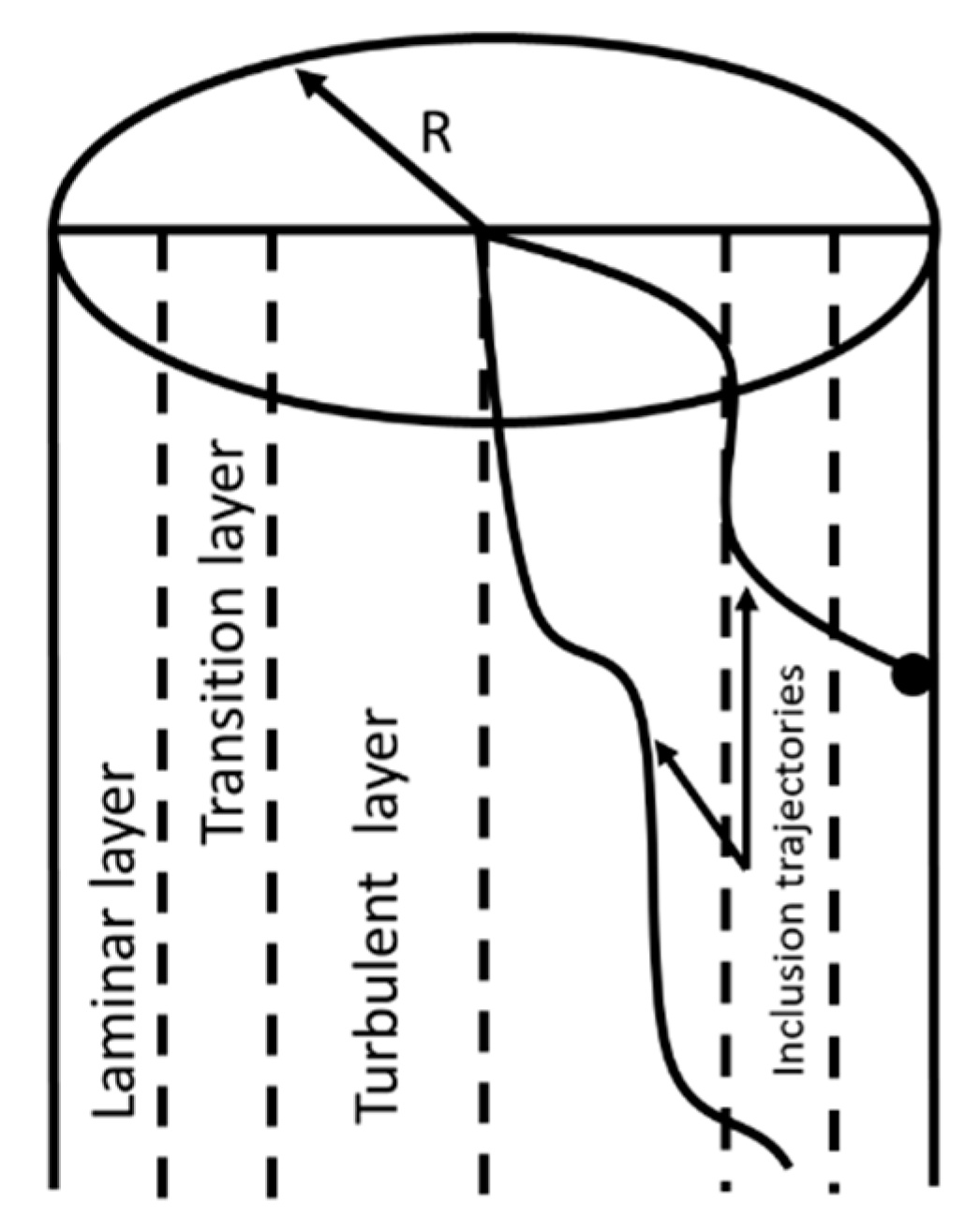
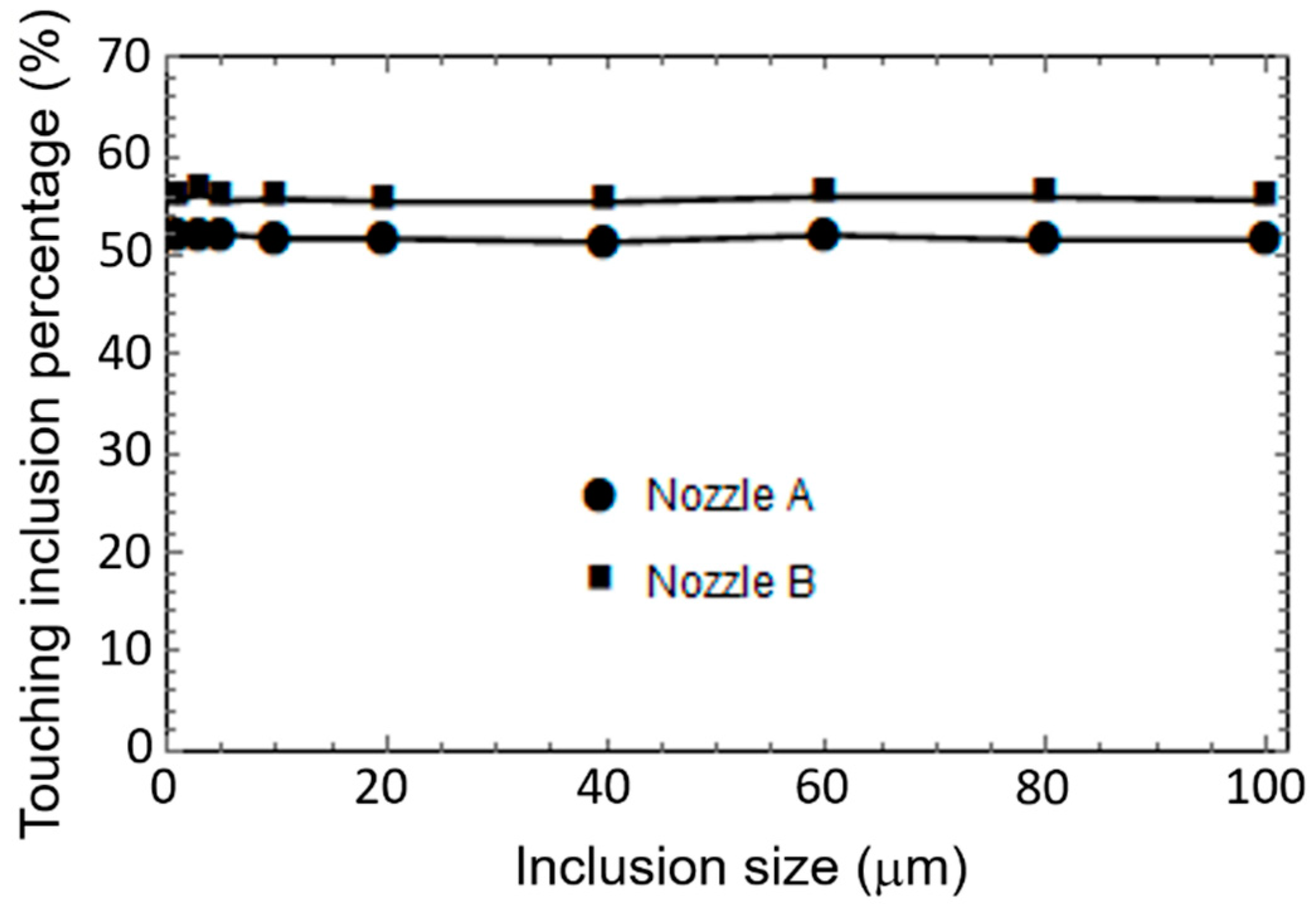

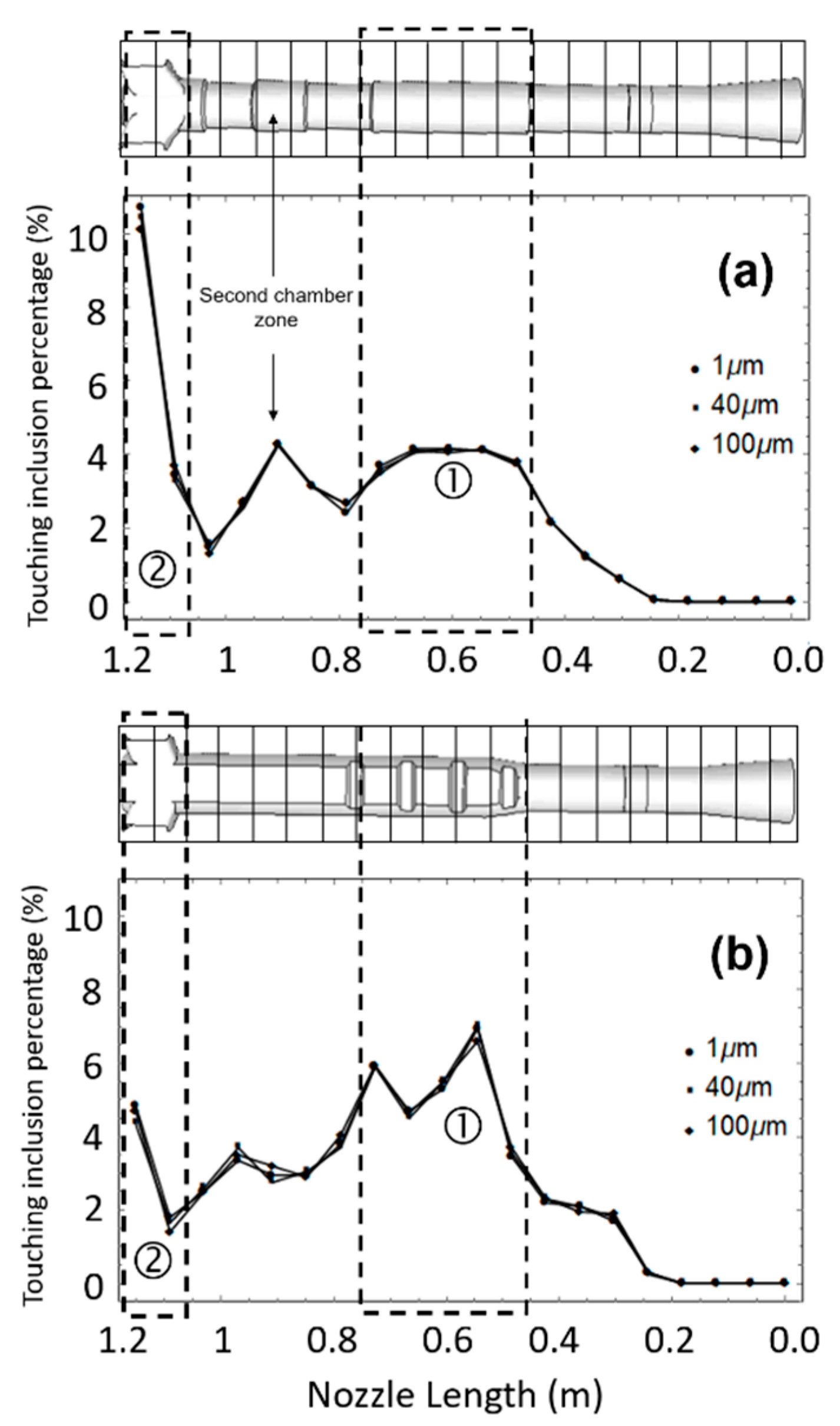
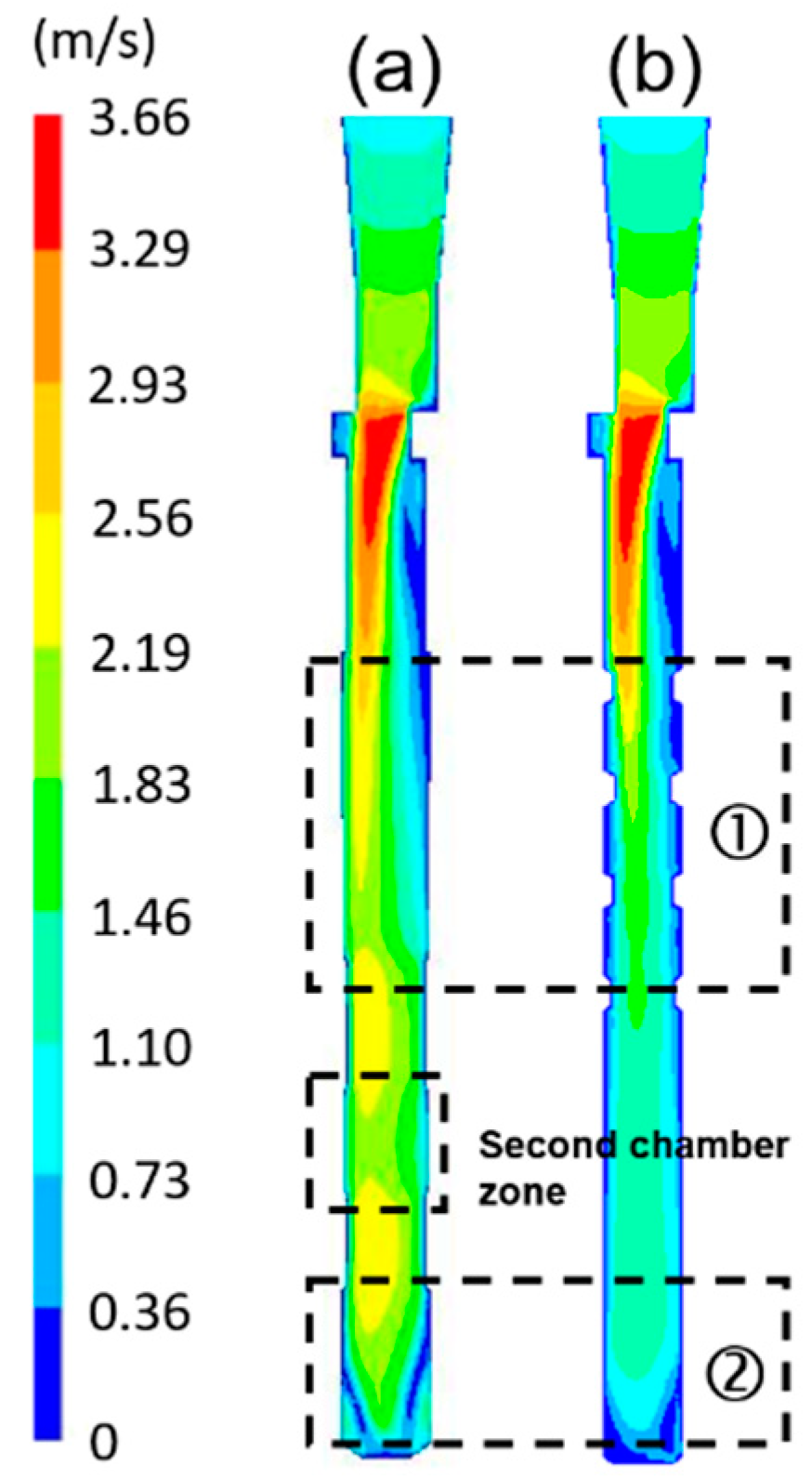
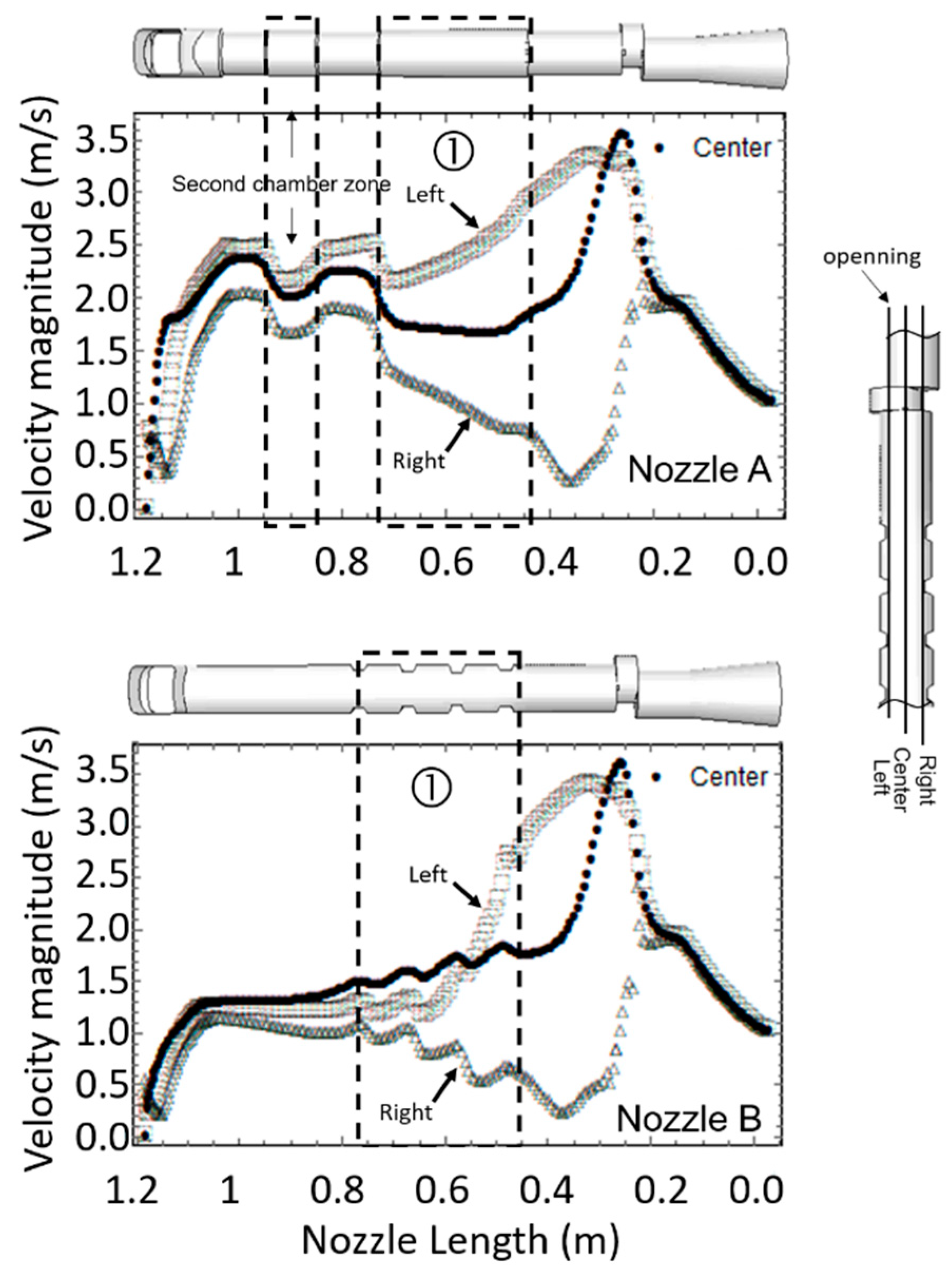

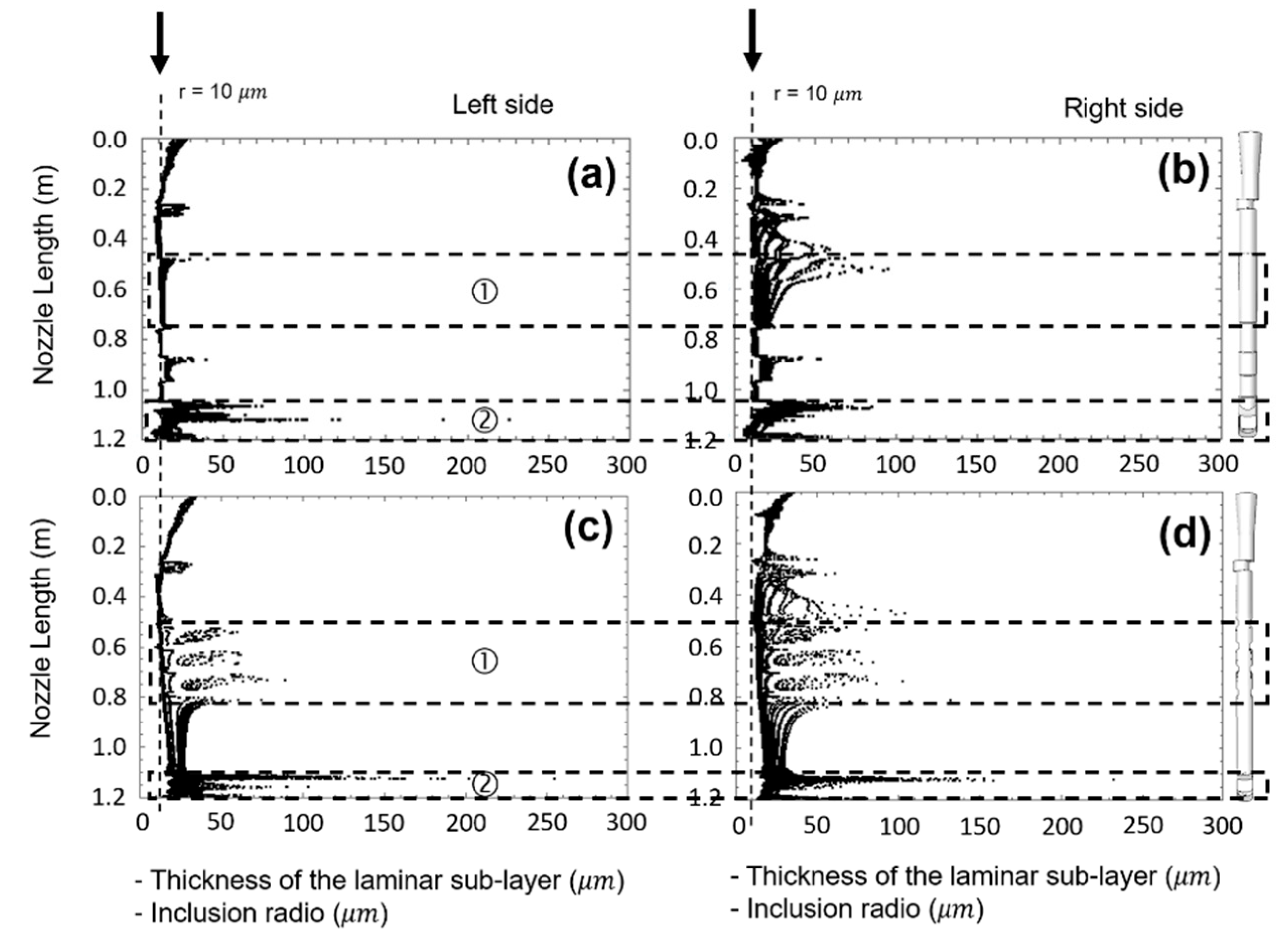
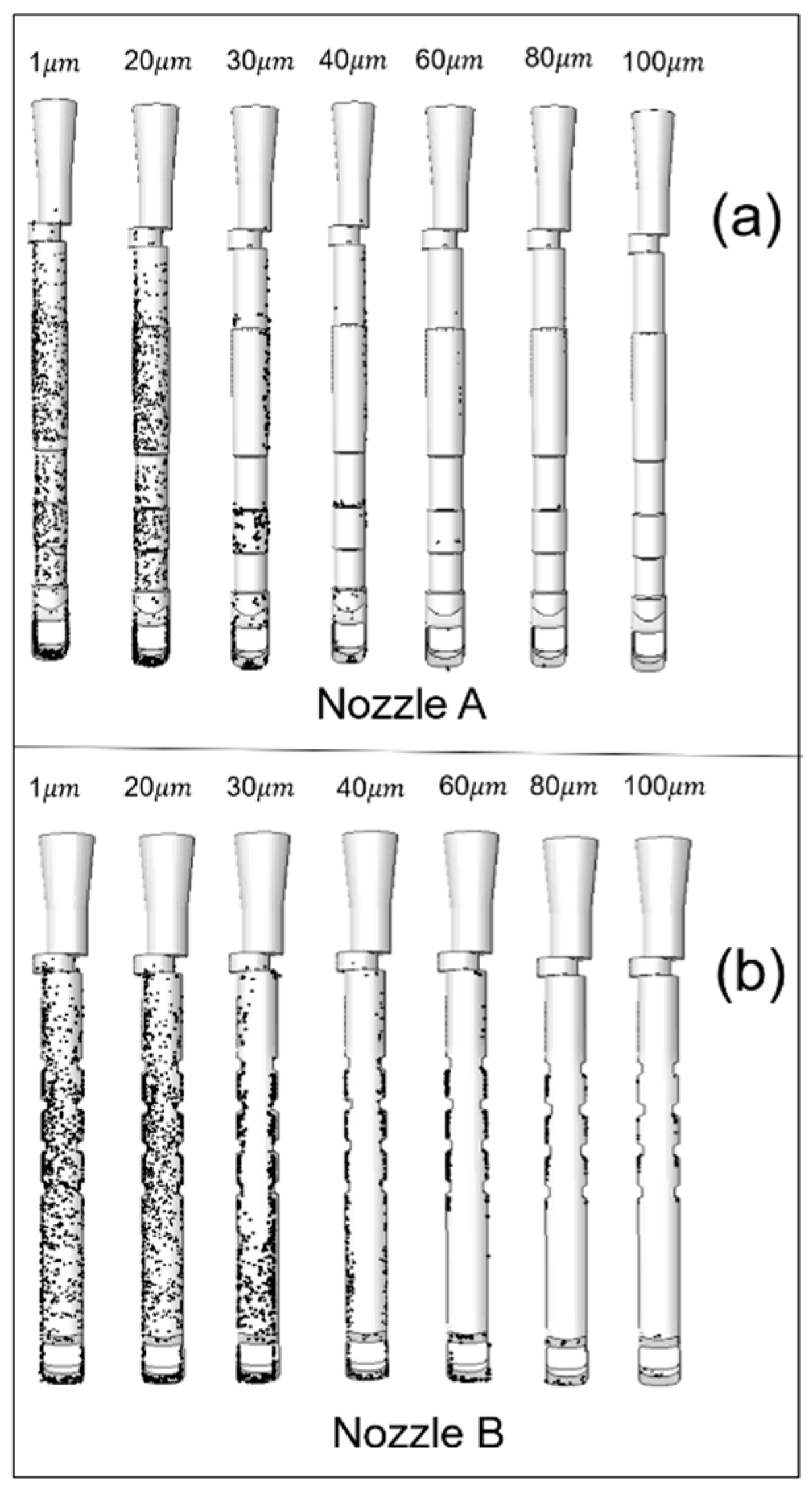
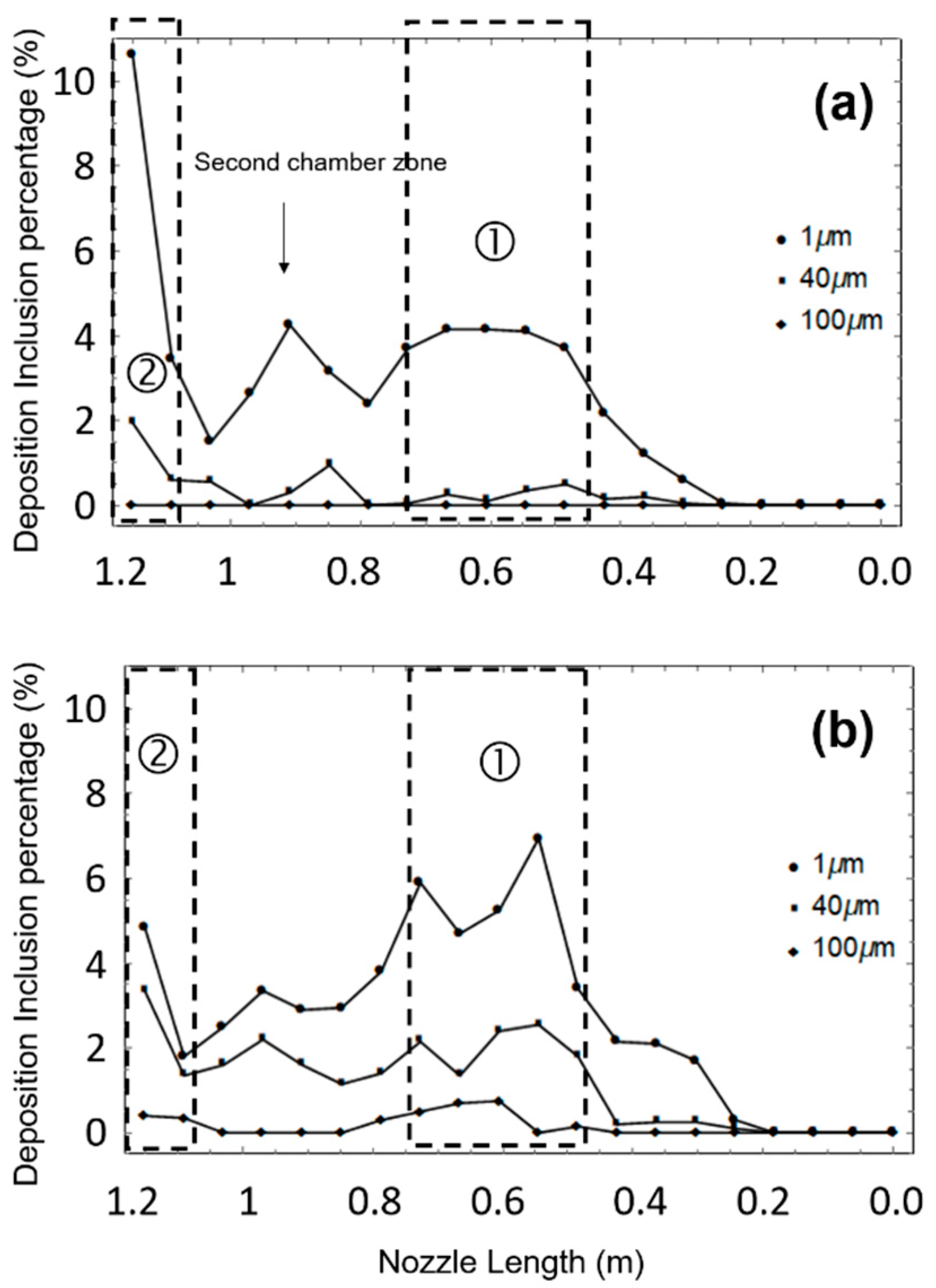
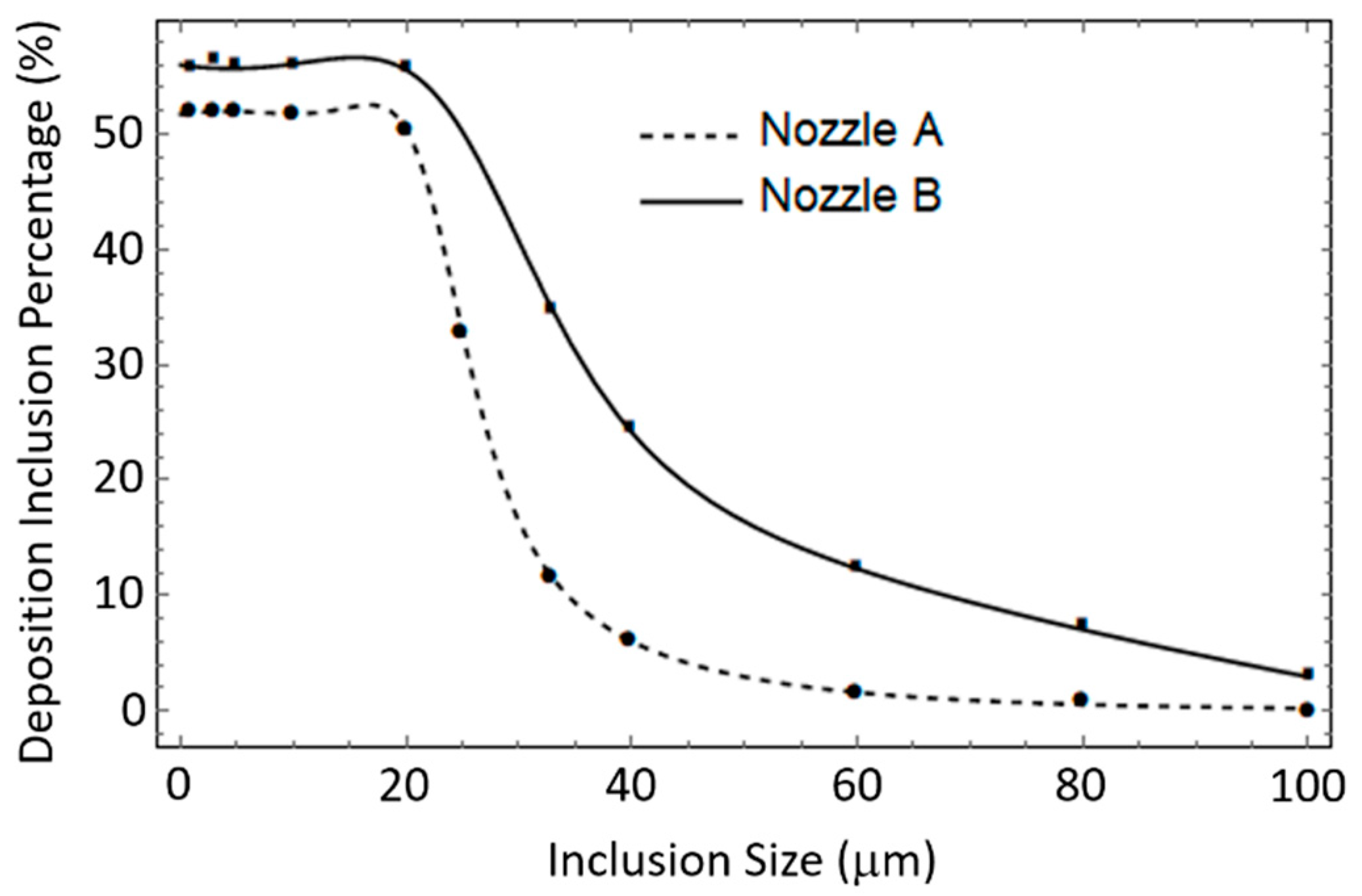
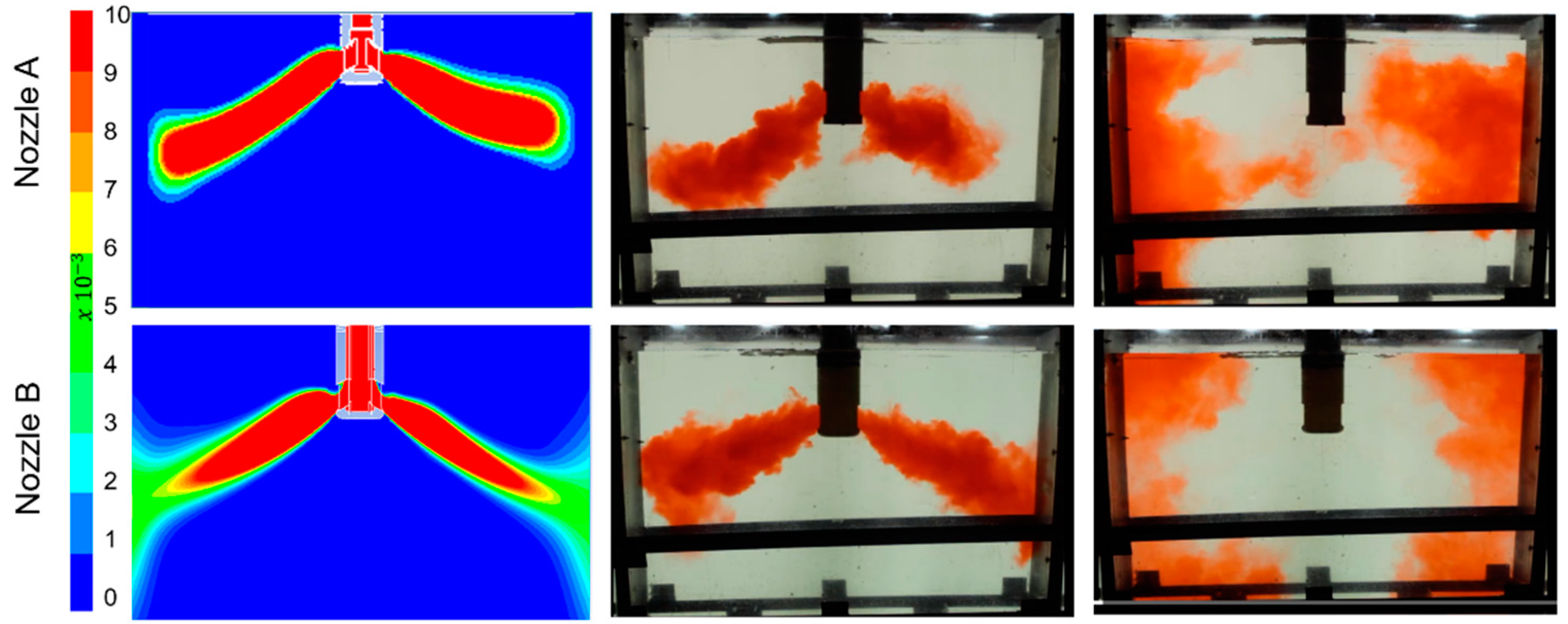

Publisher’s Note: MDPI stays neutral with regard to jurisdictional claims in published maps and institutional affiliations. |
© 2020 by the authors. Licensee MDPI, Basel, Switzerland. This article is an open access article distributed under the terms and conditions of the Creative Commons Attribution (CC BY) license (http://creativecommons.org/licenses/by/4.0/).
Share and Cite
Gutiérrez, E.; Barreto, J.d.J.; Garcia-Hernandez, S.; Morales, R.; González-Solorzano, M.G. Decrease of Nozzle Clogging through Fluid Flow Control. Metals 2020, 10, 1420. https://doi.org/10.3390/met10111420
Gutiérrez E, Barreto JdJ, Garcia-Hernandez S, Morales R, González-Solorzano MG. Decrease of Nozzle Clogging through Fluid Flow Control. Metals. 2020; 10(11):1420. https://doi.org/10.3390/met10111420
Chicago/Turabian StyleGutiérrez, Enif, Jose de Jesus Barreto, Saul Garcia-Hernandez, Rodolfo Morales, and María G. González-Solorzano. 2020. "Decrease of Nozzle Clogging through Fluid Flow Control" Metals 10, no. 11: 1420. https://doi.org/10.3390/met10111420
APA StyleGutiérrez, E., Barreto, J. d. J., Garcia-Hernandez, S., Morales, R., & González-Solorzano, M. G. (2020). Decrease of Nozzle Clogging through Fluid Flow Control. Metals, 10(11), 1420. https://doi.org/10.3390/met10111420





